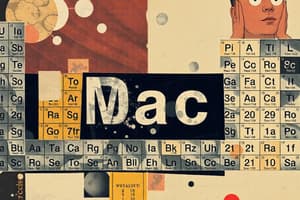Podcast
Questions and Answers
List the elements generally considered to be metalloids: _____
List the elements generally considered to be metalloids: _____
Boron, Silicon, Germanium, Arsenic, Antimony, Tellurium, Polonium, Astatine
Why are there many more metallic elements than nonmetallic elements?
Why are there many more metallic elements than nonmetallic elements?
The nonmetallic elements don't contain 'hard' surfaces like the metals. The nonmetallic elements are more brittle or gases; they only occupy the last three columns of the periodic table.
What are the major differences in properties among metals, nonmetals, and metalloids?
What are the major differences in properties among metals, nonmetals, and metalloids?
Metals are hard and shiny, conduct heat and electricity. Nonmetals are generally gases or brittle solids at room temperature; if solid, their surfaces are dull and they are insulators. Metalloids have properties of both.
Why is Mercury a metal and bromine a nonmetal?
Why is Mercury a metal and bromine a nonmetal?
Which of the three element groups does not follow the general rule?
Which of the three element groups does not follow the general rule?
When does the metallic characteristic increase in an element?
When does the metallic characteristic increase in an element?
Flashcards are hidden until you start studying
Study Notes
Metalloids
- Key metalloids include Boron, Silicon, Germanium, Arsenic, Antimony, Tellurium, Polonium, and Astatine.
Metallic vs. Nonmetallic Elements
- There are more metallic elements due to nonmetals being either brittle or gaseous.
- Nonmetallic elements occupy the last three columns of the periodic table, lacking "hard" surfaces typical of metals.
Properties of Metals, Nonmetals, and Metalloids
- Metals: Hard, shiny, good conductors of heat and electricity.
- Nonmetals: Typically gases or brittle solids at room temperature, with dull surfaces and insulating properties.
- Metalloids: Exhibit characteristics of both metals and nonmetals.
Unique Characteristics of Mercury and Bromine
- Mercury is classified as a metal while bromine is a nonmetal due to differences in their outer shell electron configurations.
Exceptions to General Rules
- Metalloids do not adhere strictly to the typical classifications of metals and nonmetals.
Metallic Characteristics Trend
- The metallic character of elements increases towards the bottom of the Periodic Table.
Studying That Suits You
Use AI to generate personalized quizzes and flashcards to suit your learning preferences.




